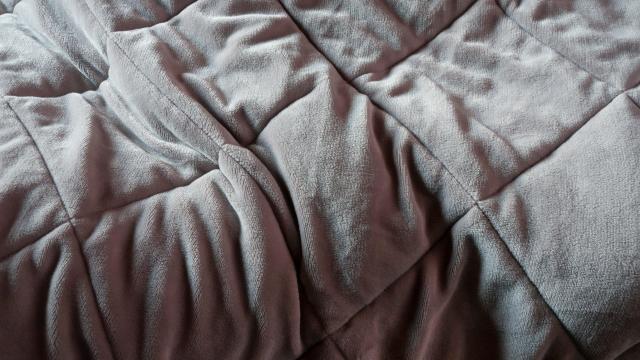A weighted blanket can be soothing if you’re having trouble sleeping, and some people find that they sleep better when they use one. Finding a blanket that’s just right for you in terms of size, weight, and design can be a challenge with such a specialty product — and they can be pretty pricey. But you can sew your own weighted blanket that is just as relaxing and effective as the store-bought variety.
To get started, you will need:
- A sewing machine
- A kitchen scale
- Flexible fabric tape measure
- Scissors
- A washout fabric marker
- Pins
- Sturdy thread
- Plastic filler beads
- Two layers of heavy duty fabric (large enough to cover your body).
Using an iron to press your pieces as you go is also helpful but not 100% necessary.
To determine how much fabric you’ll need, you can measure your height and then make a blanket that is your height by your height, minus about eight inches. Most fabric will be sold by the yard and two yards will likely be enough. Choose a fabric that has some weight to it, but is also soft. Fleece, heavier flannel, and various types of blanket-specific fabric will work well. Keep in mind that you will likely want to wash your blanket at some point, so make sure you’re choosing material that’s simple to launder. You should choose a thread that matches your fabric, or if you want to see the stitching, choose one that contrasts. For beginners, it’s easier to hide mistakes if you use a thread colour that will blend in.
How to stitch fabric for a weighted blanket
First stitch the two fabric pieces together on three sides with their faces turned in towards each other. You can double stitch this seam as it will be the edge of your blanket. Turn the fabric right side out and press the edge flat with an iron. Then stitch the outside of the three sides one half inch from the edge of your first seam, creating a border for your blanket. Now, you should have a pouch with three finished sides and one open side.
Mark out your squares and stitch your rows
Next, mark every four inches along the open edge with your fabric marker, and make lines every four inches across, and then up and down. You can make a dotted line or use whatever method will allow you to sew a straight line. Then, beginning opposite the open edge, stitch the two panels together every four inches, working towards the open edge. Once each row is stitched, you should end up with long, skinny, pockets.
Fill and stitch your squares
Put about one ounce of filler beads in each of the long pockets and pin along the line going perpendicular to your pockets. Stitch along the first horizontal line. Repeat this process, working towards the opened row until you get to the last row of squares. At this point, you should have rows of squares with filler beads in each one, except for the last row.
Finish your blanket
Put an ounce of filler beads in each of the last row of pockets and turn in the edges of the fabric and press flat. Then, double stitch a half inch from the edge to close the last row of squares and finish the edge of the blanket. Now you should have a completed blanket.

Leave a Reply
You must be logged in to post a comment.